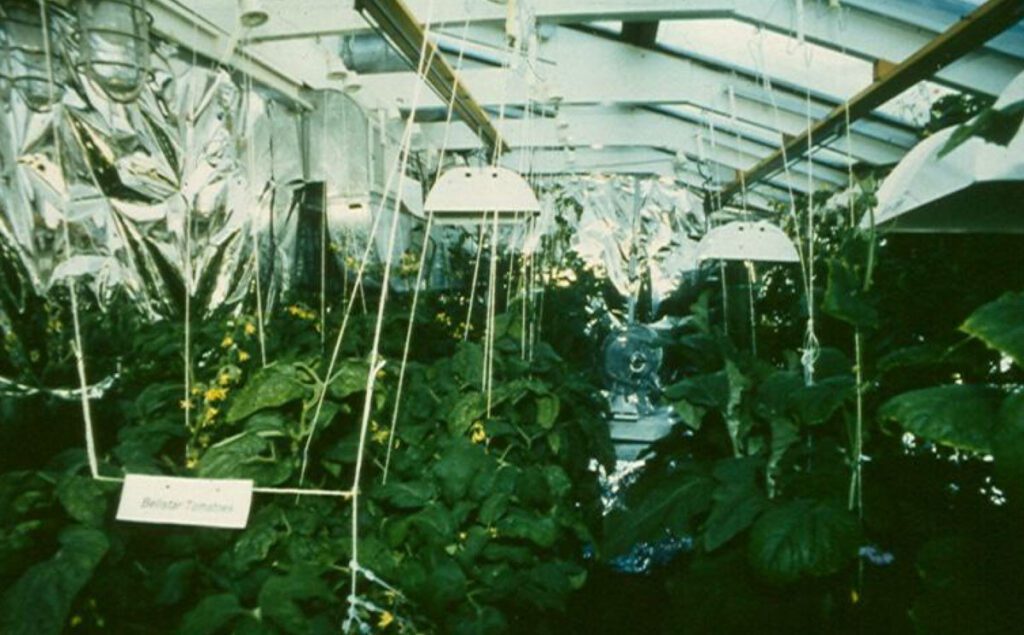South Pole Hydroponics

Growing Where No One has Grown Before
South Pole Hydroponics | Erik Biksa |
Hydroponic growing methods are an invaluable tool for sustaining the world at large. Being able to grow healthy crops without soil while conserving considerable amounts of water has many advantages. This includes the ability to grow food where it might not otherwise be possible–for example, outer space, other planets, beneath the ocean and beyond. Producing nutritious food in places like submarines or in space with hydroponics has proven possible.
However, few people know about the fact that hydroponics has enabled people to grow food in the least friendly place on the planet; and for just about twenty years now. That, naturally, is the South Pole in Antarctica where record temperatures have been recorded as low as minus 118 Degrees Fahrenheit. Yes, you read that correctly: -118 Deg F!
Above: Hydroponic crops thriving at McMurdo Station, Antarctica (early 1990’s)
The South Pole is located on the Antarctic continent and is the least hospitable place for life on earth. The ability to grow crops here has been achieved by hydroponics in specialized “greenhouses” aka growth chambers. The limitations and ability to overcome them has helped pave the way for humankind to develop the potential to grow crops in other unfriendly and even more far away places, i.e. beneath the ocean or even beyond our planet.
NASA has developed extensive research for producing food beyond our atmosphere and has successfully done so. It is said that a person’s own weight in crop fertilizer could help them grow enough food to sustain that human life for a year. The US Navy has deployed hydroponics growing deep beneath the oceans in nuclear powered submarines, where submariners may live below the surface for many months at a time.
The story of South Pole hydroponics is an interesting one, and it starts with a person by the name of Philip Sadler.
In fact, the story starts 800 miles North of the South Pole, at McMurdo Station located on the Antarctic Continent where temperatures are known to dip down as far as minus 65 Degree Fahrenheit (-65 Deg F). Originally, McMurdo was a Naval Base that was established as part of Operation Deep Freeze from 1978 to 1994, and was taken over by the National Science Foundation.
Phil, who received a Degree in Botany from the University of Arizona, had been working a career as a “hot shot” (forest fire fighter) and had a background as a heavy machinery operator. An opportunity arose to work in the Antarctic as a heavy machinery operator and he gladly seized it as the potential adventure of a lifetime.
One of the things that quickly became apparent in Antarctic living was the lack of access to fresh produce, a sentiment shared by many of the sparse inhabitants populating the continent at various international research stations and outposts. Looking further into the matter, Phil had heard stories of attempts at indoor growing of crops in living quarters as far back as 1957 with limited, if any success.
Keep in mind hydroponic growing methods had proved favorable in the Pacific Islands in the 40’s by the US Military–with the principle difference being a very favorable growing climate versus a highly inhospitable one.
However, by 1988, people knew more about growing plants under artificial lighting as a sole source of photosynthetic energy. While initially with fluorescent lights, this time period was the dawn of HID (high intensity discharge) lighting systems like Metal Halide and High Pressure Sodium.

Phil saw an opportunity here, and it turned out to be the start of people successfully producing food with hydroponics in the Antarctic and eventually as far as the South Pole. After discussing the idea with others, he found there was much support for it. Afterall, who wouldn’t want to have some fresh produce available when it’s perpetually dark and minus 60 Degrees outside?
After writing and presenting a brief white paper on the subject, he was given the go ahead. Extensive funding, unlimited access to the latest technologies available? Hardly. Phil had the authorization to salvage whatever materials he could find that could be spared and deploy them for this hydroponic growing endevor. He also received a budget of $75 for buying nutrients to be shipped from New Zealand.
If the situation wasn’t already challenging enough, he received the go-ahead for the project with only three weeks left to do it before “Winter Over” started. This is when the vast majority of people working in the Antarctic leave from September to February. Few remain there on duty during the Winter Over period. However, these are the people who would benefit the most from fresh actively growing hydroponic crops.
And so it began. Phil commenced constructing structures for hydroponics growing after his regular 12 hour daily work shift. Before he knew it, he had over a dozen volunteers doing the same with him after long work days in tough conditions. Perhaps a testament to how much humans value growing and enjoying crops and the sense of community and comradery that can develop in such harsh environments.
Once two salvaged Navy modular buildings were bolted together, un partitioned and had the interior surfaces lined with reflective film used as shipping insulation, work on the interior growing system could begin in earnest. As fate would have it, the Navy had a mile of 6” PVC pipe that as it turned out, could not be used for an intended application, so it was up for grabs. Hence, the first hydroponic grow tube systems were born.
Naturally, plants don’t grow very well in the dark. Several HPS (high pressure sodium) lighting systems typically used for lighting outdoors became available to Phil and were installed in the new Antarctic “greenhouses”.
It’s interesting to note that the design and construction of these first Antarctic greenhouses were born out of pure necessity, and yet, became mainstays in commercially available indoor growing equipment set-ups, ie hydroponic grow tubes, reflective walls and HPS lighting systems.
The system proved to be a success. Healthy plants like tomatoes, peppers and leafy greens were grown to maturity by several volunteers; in spite of the challenges inherent to living and working in Antarctica. Remember, this was all done with mostly salvaged materials and the dedication of like minded volunteers who already put in long work days in tough conditions.
The lettuce trays were stacked vertically to maximize yield in the limited space available. Vermiculite, a by-product of shipping packaging, proved to be an excellent growing medium for the leafy greens.
The six inch grow tube systems were equally a success for larger vine crops, so much so, in fact, that the plants became easily crowded when not keeping up with pruning and training.
In 1994 McMurdo Dorm 201 was being remodelled, which included the installation of some double pane glass window units. Some of these panes made their way into an extension built onto the McMudro growth chamber/greenhouse, adding some more space for crop growing with the additional benefit of capturing natural sunlight, when available.
Phil was not able to return to build the growing trays in the new glasshouse extension onto the original greenhouse, however, Food Services Warren Hoy was up to the task. Soon, the most Southern Greenhouse in the world was producing healthy food crops using natural and supplemental HID lighting.
One can only imagine the sense of the “oasis” that was created with the McMurdo Greenhouse for the people who inhabited there, particularly the Winter Over crowd. It is not difficult to surmise that this would improve the quality of life, overall outlook and mental health of people working in conditions of prolonged cold darkness that is otherwise devoid of any plant life, let alone fresh picked produce packed with nutrition.
If this wasn’t successful enough, Phil wanted to take this a step further; and that step is a big one because we are talking about 800 miles further, clear to the South Pole with hydroponics.
As mentioned, conditions in the South Pole make it the least hospitable place on earth to grow plants where record temperatures have been recorded as low as minus 118 Degrees Fahrenheit.
In 1990 Phil was able to sell the National Science Foundation and Office of Polar Programs on creating a South Pole Greenhouse based on the successful initiative with the McMurdo Antarctic Greenhouse. A small volunteer group was co-ordinated for the South Pole hydroponics project, with Kitt Hughes as manager.
Much like the McMurdo project, it was a labor of love from the volunteers and a lot of resourcefulness. When South Pole workers who volunteered for the project came to the McMurdo station for R&R they received training and information from Phil on hydroponic growing that they could take back with them and put to use at the South Pole location.
The South Pole hydroponics greenhouse itself was constructed from a repurposed paint shack. Improvements included lining the wood sheathed structure with insulation and reflective materials. A curtain was installed inside to keep light away from photoperiod sensitive plants sharing the growing area.
The growing systems were pre-fabricated by Phil at McMurdo and were based on the successful vermiculite culture set-up that had been producing an abundance of healthy and nutritious greens.
At the end of the McMurdo season, Philip flew out to the South Pole research station and assembled the systems with the help of five volunteers. This was the beginning of the first South Pole greenhouse. Kathleen McDermott came on board with managing the greenhouse which continued production for a second season before the South Pole greenhouse was rebuilt on top of the station bathroom module (with Phil unofficially assisting the H&N engineers before moving the systems into the new structure).
Above: The original South Pole hydroponics greenhouse (1994)
In 2004 a replacement chamber was constructed for the station at the U of A Controlled Environment Agriculture Centre–bringing leading edge equipment and operations practices. This engineered growth chamber is still in use today; and enjoyed as the first Antarctic Greenhouses were by crew and visitors alike.
Above: The CEAC built South Pole Hydroponics Module (2004)
It seems the pioneering work of Phil Sadler, the groups of volunteers and researchers that followed in the Antarctic & South Pole projects created foundational work for present studies being conducted.
Consider that growing food in a closed environment in the South Pole presents many of the challenges and limitations that may face human beings colonizing other planets. The practical experience gained from these limitations in Antarctica projects are being put to work today as countries from around the world begin to prepare people for living and growing crops beyond our planet.
Stay tuned for further discussion on growing crops with hydroponics where it would otherwise not be possible!
MORE About Phil Sadler & the University of Arizona CEA Centre HERE
Present Day South Pole Greenhouse:
German Aerospace Research in Antarctica:
The post South Pole Hydroponics appeared first on GROZINE.










